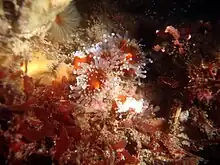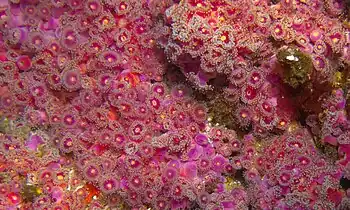Corynactis californica
Corynactis californica is a brightly colored colonial anthozoan corallimorph. Unlike the Atlantic true sea anemone, Actinia fragacea, that bears the same common name, strawberry anemone, this species is a member of the order Corallimorpharia, and is the only member found in the North American West Coast.[2] Other common names include club-tipped anemone and strawberry corallimorpharian. The anemone can live up to at least 50 meters deep on vertical rock walls, and at the bottom of kelp forests.[3][4] It is known to carpet the bottom of some areas, like Campbell River in British Columbia, and Monterey Bay in California.
| Corynactis californica | |
|---|---|
 | |
| Scientific classification | |
| Domain: | Eukaryota |
| Kingdom: | Animalia |
| Phylum: | Cnidaria |
| Class: | Hexacorallia |
| Order: | Corallimorpharia |
| Family: | Corallimorphidae |
| Genus: | Corynactis |
| Species: | C. californica |
| Binomial name | |
| Corynactis californica Carlgren, 1936[1] | |
.jpg.webp)
The strawberry anemone grows no larger than 2.5 centimeters. The anemone can be red, pink, purple, brown, yellow, or completely white.[5] They possess tentacles that are white or transparent with bulbous tips. The strawberry anemone resembles sea anemones in that they lack a calcareous skeleton, but are closer related to stony corals in that they lack basilar muscles. This species lacks photosynthetic symbionts.[6]
The strawberry anemone is known to reproduce both sexually and asexually, with asexual reproduction used to cover more available ground.[2][3] The anemone is known to attack other species of sea anemone and coral that they are competitive with, as to take over the areas left behind by the previous occupants.[3] They attack with toxins passed through prolonged contact. The same method is used in self-defense and in food consumption.
Reproduction
The strawberry anemone can reproduce both sexually and asexually through fission and budding.[4] It is dioecious, and produces both egg strings and testicular cysts in sync through all polyps in a clone.[2] The gametes are stored in the mesoglea, in the gastrovascular cavity. They are typically produced in an annual cycle between August and November, and are spawned from late November to mid-December. Gametes are released into the surrounding water, where they form embryos that turn into planktonic larvae within 2–3 days.
Behavior
The strawberry anemone has been shown to attack competing species of sea anemone and coral when in prolonged contact with them.[3] Attacks are conducted after prolonged contact between the strawberry anemone's tentacles and rival species. The attack is done through releasing their mesenteries and attaching their mesenterial filaments, thin white strings that contain enzymes and toxins, with the rival species. With prolonged contact, they are able to kill off these species, and asexually reproduce to take over the space left behind. However, the strawberry anemone does not attack other members of its own species, a unique trait amongst surrounding anemone species.
The strawberry anemone also used their mesenterial filaments for other reasons, including assisting in the consumption of larger prey, or as a self-defence mechanism against predators such as Dermasterias imbricata.[3][4]
Habitat
Studies conducted on Corynactis californica suggest that the anemone grows well under the canopies of macroalgae rather than outside of them.[4] Species of macroalgae that the strawberry anemone live under include Macrocystis pyrifera and Eisenia arborea. Eisenia arborea may assist the anemone in protecting planktonic larvae, and directing food particles to polyps.
References
- "WoRMS - World Register of Marine Species - Corynactis californica Carlgren, 1936". www.marinespecies.org. Retrieved 16 July 2010.
- Holts, L. J.; Beauchamp, K. A. (May 1993). "Sexual reproduction in the corallimorpharian sea anemone Corynactis californica in a central California kelp forest". Marine Biology. 116 (1): 129–136. doi:10.1007/bf00350740. ISSN 0025-3162. S2CID 86638248.
- CHADWICK, NANETTE E. (August 1987). "Interspecific Aggressive Behavior of the Corallimorpharian Corynactis californica (Cnidaria: Anthozoa): Effects on Sympatric Corals and Sea Anemones". The Biological Bulletin. 173 (1): 110–125. doi:10.2307/1541866. ISSN 0006-3185. JSTOR 1541866. PMID 29315001.
- Morrow, K; Carpenter, R (2008-06-09). "Shallow kelp canopies mediate macroalgal composition: effects on the distribution and abundance of Corynactis californica (Corallimorpharia)". Marine Ecology Progress Series. 361: 119–127. Bibcode:2008MEPS..361..119M. doi:10.3354/meps07371. ISSN 0171-8630.
- "Corynactis_californica". people.ucsc.edu. Retrieved 2019-01-20.
- Schnitzler, Christine E.; Keenan, Robert J.; McCord, Robert; Matysik, Artur; Christianson, Lynne M.; Haddock, Steven H. D. (2008-05-01). "Spectral Diversity of Fluorescent Proteins from the Anthozoan Corynactis californica". Marine Biotechnology. 10 (3): 328–342. doi:10.1007/s10126-007-9072-7. ISSN 1436-2236. PMID 18330643. S2CID 9664558.
- Carlgren, O. (1949). A survey of Ptychodactiaria, Corallimorpharia, and Actiniaria. Kungl. Svenska Vetenskapsakademiens Handlingar 1: 1-121.
- "Corynactis californica". Integrated Taxonomic Information System.
